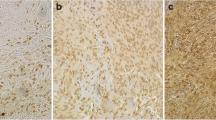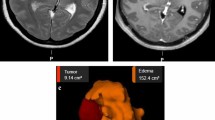Abstract
Various degrees of peritumoral brain edema (PTBE) are observed in patients with intracranial meningiomas. Factors affecting the occurrence of PTBE in intracranial meningioma were investigated. PTBE was investigated retrospectively for 110 patients with primary intracranial meningiomas. Predictive factors related to PTBE were analyzed, for example patient age, sex, magnetic resonance imaging features (contrast enhancement, tumor shape, tumor location, tumor volume), angiographical features (tumor stain, pial–cortical arterial supply, venous obstruction), and histopathological features (histological subtypes, mindbomb homolog 1 labeling index (MIB1-LI)). Histological subtypes were classified into World Health Organization (WHO) grade I common type (meningothelial, transitional, fibrous), grade I uncommon type, and grade II and III types. The extent of PTBE was assessed by calculation of the edema index (EI). PTBE was present in 53 cases (48 %). Male sex, heterogeneous enhancement, superficial location, tumor volume (≥10 cm3), remarkable tumor stain, pial supply, venous obstruction, malignant pathology, and MIB1-LI ≥4 % were correlated with PTBE in univariate analysis. Pial supply and remarkable tumor stain were correlated with PTBE in multivariate analysis. WHO grade I uncommon type had obviously higher EI than WHO grade I common type, and WHO grade II and III types (P < 0.001). Seven cases with prominently high EI (EI ≥10) were all WHO grade I uncommon type, including angiomatous, microcystic, secretory, and lymphoplasmacyte-rich meningioma. Prominently extensive PTBE might indicate the presence of WHO grade I uncommon type meningioma.



Similar content being viewed by others
References
Kalkanis SN, Carroll RS, Zhang J, Zamani AA, Black PM (1996) Correlation of vascular endothelial growth factor messenger RNA expression with peritumoral vasogenic cerebral edema in meningiomas. J Neurosurg 85:1095–1101
Lee KJ, Joo WI, Rha HK, Park HK, Cough JK, Hong YK, Park CK (2008) Peritumoral brain edema in meningiomas: correlations between magnetic resonance imaging, angiography, and pathology. Surg Neurol 69:350–355
Nakano T, Asano K, Miura H, Itoh S, Suzuki S (2002) Meningiomas with brain edema: radiological characteristics on MRI and review of the literature. Clin Imaging 26:243–249
Park KJ, Kang SH, Chae YS, Yu MO, Cho TH, Suh JK, Lee HK, Chung YG (2010) Influence of interleukin-6 on the development of peritumoral brain edema in meningiomas. J Neurosurg 112:73–80
Simis A, Pires de Aguiar PH, Leite CC, Santana PA Jr, Rosemberg S, Teixeira MJ (2008) Peritumoral brain edema in benign meningiomas: correlation with clinical, radiologic, and surgical factors and possible role on recurrence. Surg Neurol 70:471–477
Tamiya T, Ono Y, Matsumoto K, Ohmoto T (2001) Peritumoral brain edema in intracranial meningiomas: effects of radiological and histological factors. Neurosurgery 49:1046–1052
Bitzer M, Wöckel L, Morgalla M, Keller C, Friese S, Heiss E, Meyermann R, Grote E, Voigt K (1997) Peritumoural brain oedema in intracranial meningiomas: influence of tumour size, location and histology. Acta Neurochir (Wien) 139:1136–1142
Bitzer M, Klose U, Geist-Barth B, Nägele T, Schick F, Morgalla M, Claussen CD, Voigt K (2002) Alterations in diffusion and perfusion in the pathogenesis of peritumoral brain edema in meningiomas. Eur Radiol 12:2062–2076
Gilbert JJ, Paulseth JE, Coates RK, Malott D (1983) Cerebral edema associated with meningiomas. Neurosurgery 12:599–605
Bitzer M, Opitz H, Popp J, Morgalla M, Gruber A, Heiss E, Voigt K (1998) Angiogenesis and brain oedema in intracranial meningiomas: influence of vascular endothelial growth factor. Acta Neurochir (Wien) 140:333–340
Bradac GB, Ferszt R, Bender A, Schörner W (1986) Peritumoral edema in meningiomas. A radiological and histological study. Neuroradiology 28:304–312
Inamura T, Nishio S, Takeshita I, Fujiwara S, Fukui M (1992) Peritumoral brain edema in meningiomas—influence of vascular supply on its development. Neurosurgery 31:179–185
Maiuri F, Gangemi M, Cirillo S, Delehaye L, Gallicchio B, Carandente M, Giamundo A (1987) Cerebral edema associated with meningiomas. Surg Neurol 27:64–68
Yoshioka H, Hama S, Taniguchi E, Sugiyama K, Arita K, Kurisu K (1999) Peritumoral brain edema associated with meningioma: influence of vascular endothelial growth factor expression and vascular blood supply. Cancer 85:936–944
Stevens JM, Ruiz JS, Kendall BE (1983) Observations on peritumoral oedema in meningioma. Part II: Mechanisms of oedema production. Neuroradiology 25:125–131
Bitzer M, Topka H, Morgalla M, Friese S, Wockel L, Voigt K (1998) Tumor-related venous obstruction and development of peritumoral brain edema in meningiomas. Neurosurgery 42:730–737
Hiyama H, Kubo O, Tajika Y, Tohyama T, Takakura K (2004) Meningiomas associated with peritumoural venous stasis: three types on cerebral angiogram. Acta Neurochir (Wien) 129:31–38
Philippon J, Foncin JF, Grob R, Srour A, Poisson M, Pertuiset BF (1984) Cerebral edema associated with meningiomas: possible role of a secretory–excretory phenomenon. Neurosurgery 14:295–301
Benzel EC, Gelder FB (1988) Correlation between sex hormone binding and peritumoral edema in intracranial meningiomas. Neurosurgery 23:169–174
Schmid S, Aboul-Enein F, Pfisterer W, Birkner T, Stadek C, Knosp E (2010) Vascular endothelial growth factor: the major factor for tumor neovascularization and edema formation in meningioma patients. Neurosurgery 67:1703–1708
Vignes JR, Sesay M, Rezajooi K, Gimbert E, Liguoro D (2008) Peritumoral edema and prognosis in intracranial meningioma surgery. J Clin Neurosci 15:764–768
Kleihues P, Cavenee WK (2000) Pathology and genetics of tumors of the nervous system. International Agency for Research on Cancer, Lyon, pp 164–172
Tanaka G, Nakazato Y (2004) Conditional entropy as an indicator of pleomorphism in astrocytic tumors. Neuropathology 24:183–193
Perry A, Stafford SL, Scheithauer BW, Suman VJ, Lohse CM (1998) The prognostic significance of MIB-1, p53, and DNA flow cytometry in completely resected primary meningiomas. Cancer 82:2262–2269
Perry A, Scheithauer BW, Stafford SL, Lohse CM, Wollan PC (1999) “Malignancy” in meningiomas: a clinicopathologic study of 116 patients, with grading implications. Cancer 85:2046–2056
Abry E, Thomassen IØ, Salvesen ØO, Torp SH (2010) The significance of Ki-67/MIB-1 labeling index in human meningiomas: a literature study. Pathol Res Pract 206:810–815
Oya S, Kim SH, Sade B, Lee JH (2011) The natural history of intracranial meningiomas. J Neurosurg 114:1250–1256
Kasuya H, Kubo O, Tanaka M, Amano K, Kato K, Hori T (2006) Clinical and radiological features related to the growth potential of meningioma. Neurosurg Rev 29:293–296
Firsching RP, Fischer A, Peters R, Thun F, Klug N (1990) Growth rate of incidental meningiomas. J Neurosurg 73:545–547
Ide M, Jimbo M, Yamamoto M, Umebara Y, Hagiwara S, Kubo O (1996) MIB-1 staining index and peritumoral brain edema of meningiomas. Cancer 78:133–143
Matsuno A, Fujimaki T, Sasaki T, Nagashima T, Ide T, Asai A, Matsuura R, Utsunomiya H, Kirino T (1996) Clinical and histopathological analysis of proliferative potentials of recurrent and non-recurrent meningiomas. Acta Neuropathol 91:504–510
Elster AD, Challa VR, Gilbert TH, Richardson DN, Contento JC (1989) Meningiomas: MR and histopathologic features. Radiology 170:857–862
Lobato RD, Alday R, Gómez PA, Rivas JJ, Domínguez J, Cabrera A, Madero S, Ayerbe J (1996) Brain oedema in patients with intracranial meningioma. Correlation between clinical, radiological, and histological factors and the presence and intensity of oedema. Acta Neurochir (Wien) 138:485–494
Provias J, Claffey K, delAguila L, Lau N, Feldkamp M, Guha A (1997) Meningiomas: role of vascular endothelial growth factor/vascular permeability factor in angiogenesis and peritumoral edema. Neurosurgery 40:1016–1026
Alvernia JE, Sindou MP (2004) Preoperative neuroimaging findings as a predictor of the surgical plane of cleavage: prospective study of 100 consecutive cases of intracranial meningioma. J Neurosurg 100:422–430
Alvernia JE, Dang ND, Sindou MP (2011) Convexity meningiomas: study of recurrence factors with special emphasis on the cleavage plane in a series of 100 consecutive patients. J Neurosurg 115:491–498
Ildan F, Tuna M, Göçer AP, Boyar B, Bağdatoğlu H, Sen O, Haciyakupoglu S, Burgut HR (1999) Correlation of the relationships of brain-tumor interfaces, magnetic resonance imaging, and angiographic findings to predict cleavage of meningiomas. J Neurosurg 91:384–390
Hasselblatt M, Nolte KW, Paulus W (2004) Angiomatous meningioma—a clinicopathologic study of 38 cases. Am J Surg Pathol 28:390–393
Goldman CK, Bharara S, Palmer CA, Vitek J, Tsai JC, Weiss HL, Gillespie GY (1997) Brain edema in meningiomas is associated with increased vascular endothelial growth factor expression. Neurosurgery 40:1269–1277
Connolly DT (1991) Vascular permeability factor: a unique regulator of blood vessel function. J Cell Biochem 47:219–223
Roberts WG, Palade GE (1997) Neovasculature induced by vascular endothelial growth factor is fenestrated. Cancer Res 57:765–772
Kamp MA, Beseoglu K, Eicker S, Steiger HJ, Hänggi D (2011) Secretory meningiomas: systematic analysis of epidemiological, clinical, and radiological features. Acta Neurochir (Wien) 153:457–465
Tirakotai W, Mennel HD, Celik I, Hellwig D, Bertalanffy H, Riegel T (2006) Secretory meningioma: immunohistochemical findings and evaluation of mast cell infiltration. Neurosurg Rev 29:41–48
Regelsberger J, Hagel C, Emami P, Ries T, Heese O, Westphal M (2009) Secretory meningiomas: a benign subgroup causing life-threatening complications. Neuro Oncol 11:819–824
Christov C, Lechapt-Zalcman E, Adle-Biassette H, Nachev S, Gherardi RK (1999) Vascular permeability factor/vascular endothelial growth factor (VPF/VEGF) and its receptor flt-1 in microcystic meningiomas. Acta Neuropathol 98:414–420
Nishio S, Takeshita I, Morioka T, Fukui M (1994) Microcystic meningiomas: clinicopathological features of 6 cases. Neurol Res 16:251–256
Paek SH, Kim SH, Chang KH, Park CK, Kim JE, Kim DG, Park SH, Jung HW (2005) Microcystic meningiomas: radiological characteristics of 16 cases. Acta Neurochir (Wien) 147:965–972
Liu JL, Zhou JL, Ma YH, Dong C (2012) An analysis of the magnetic resonance imaging and pathology of intracal lymphoplasmacyte-rich meningioma. Eur J Radiol 81:968–973
Katayama S, Fukuhara T, Wani T, Namba S, Yamadori I (1997) Cystic lymphoplasmacyte-rich meningioma–case report. Neurol Med Chir (Tokyo) 37:275–278
Conflict of interest
None.
Author information
Authors and Affiliations
Corresponding author
Rights and permissions
About this article
Cite this article
Osawa, T., Tosaka, M., Nagaishi, M. et al. Factors affecting peritumoral brain edema in meningioma: special histological subtypes with prominently extensive edema. J Neurooncol 111, 49–57 (2013). https://doi.org/10.1007/s11060-012-0989-y
Received:
Accepted:
Published:
Issue Date:
DOI: https://doi.org/10.1007/s11060-012-0989-y




